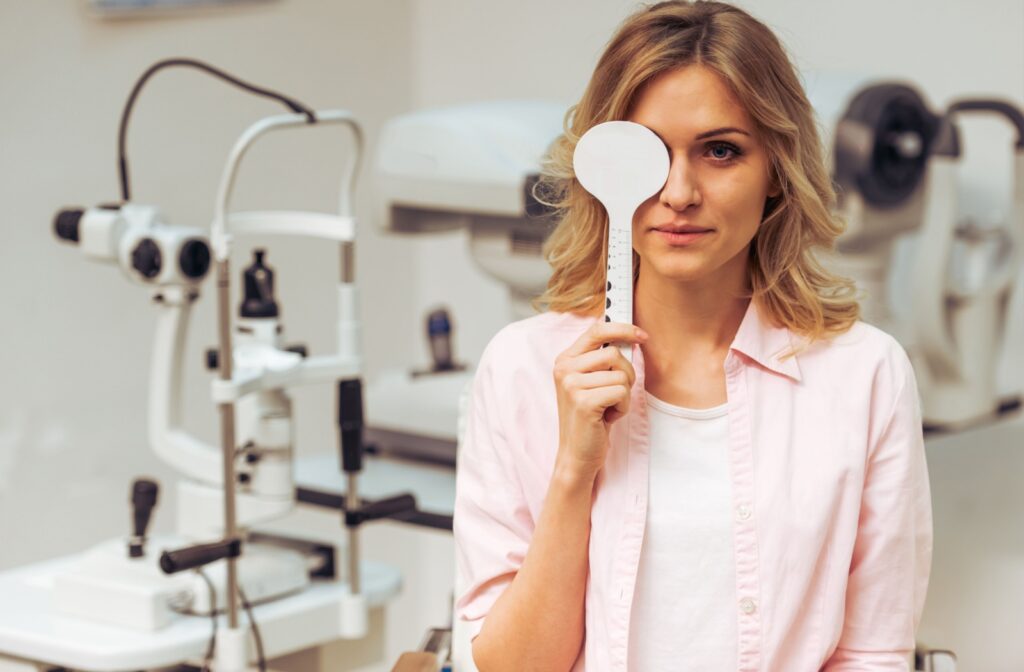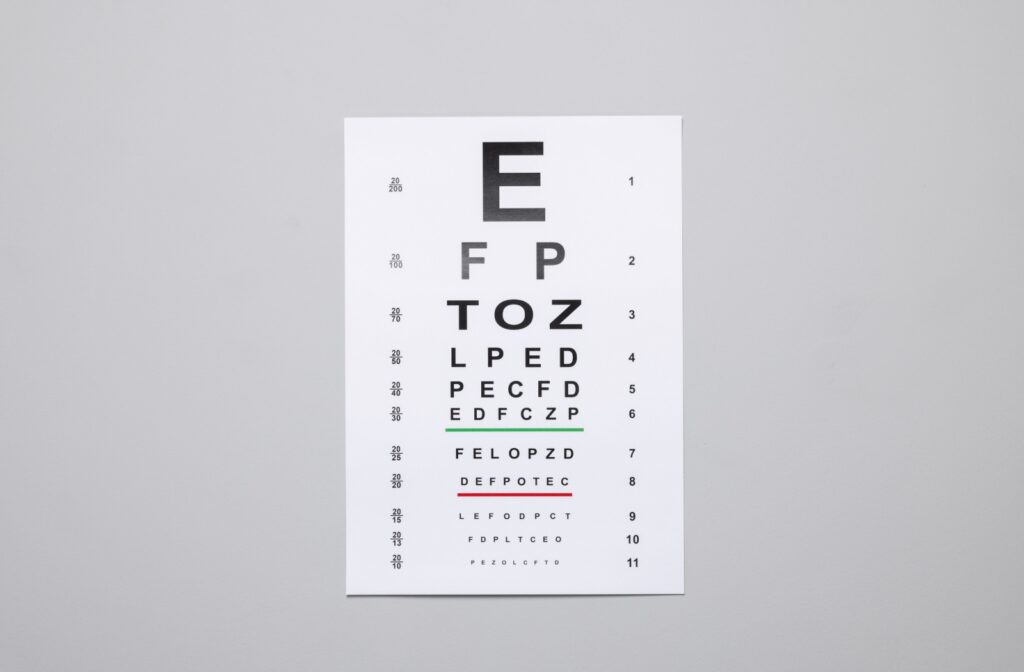You probably know the drill. You walk into the examination room, sit in the chair, and look toward the far wall at a chart of letters that starts with a giant “E.” It’s a familiar part of visiting your eye doctor, and a classic symbol of checking your vision.
But have you ever wondered if that chart is always the same one you saw at your last visit? No, the letters on an eye exam chart are not always the same, and for a very good reason. We use different versions of the chart to get a true and accurate measurement of your vision during your eye exam.
The Classic Big E Chart & Its Purpose
What Is the Snellen Chart?
That classic eye chart is called a Snellen chart, and it’s named after the doctor who created it in the 1860s. It’s designed with a single letter at the top and rows of progressively smaller letters below. The purpose of this chart is it helps us measure your visual acuity.
Visual acuity is just a way of describing the clearness or sharpness of your vision. The Snellen chart gives us a standard way to see how well you can identify letters from a specific distance. It’s a simple yet effective tool we’ve used for generations.
How This Chart Measures Your Vision
During your exam, you’ll read the smallest line of letters you can see clearly from 20 feet away. If you can read the line designated as “20/20,” it means you have typical visual acuity. You can see at 20 feet what a person with normal vision can see at 20 feet.
If you have 20/40 vision, for example, this means you need to be 20 feet away to see what a person with standard vision can see from 40 feet away.
The Snellen chart is a quick way for us to get a baseline measurement of your sight. It’s the first step in determining if you need corrective lenses.
Are the Letters on the Chart Always the Same?
Why Your Eye Doctor May Change the Chart
It’s important that your vision test is accurate, and a big part of that is making sure you aren’t reading from memory. If you saw the same chart every time, your brain might start to memorize the letter sequences. This could give an inaccurate result, making your vision seem sharper than it really is.
By changing the chart, we get a fresh look at your vision at every appointment. This helps us track any real changes over time, whether your vision is stable, improving, or needs a new prescription. Our goal is an honest assessment of your eyesight.
Different Versions for Different Visits
To prevent memorization, we have several different versions of the Snellen chart in our office. We can also use digital projectors that can randomize the letters with the push of a button.
So, the next time you visit your eye doctor in San Diego, don’t be surprised if the letters look unfamiliar. It’s an intentional part of our process. It helps us give you the most precise care possible.

More Than Just the Snellen Chart
Charts for Kids & Non-Readers
What about young children or individuals who can’t read the alphabet? For children’s eye exams, we have special charts, too. Vision care is for everyone, regardless of their age or ability to read letters.
Two common examples include:
- The Tumbling E Chart: This chart uses only the letter “E” in different orientations. The child can simply point their fingers to show which way the “legs” of the E are facing—up, down, left, or right.
- Picture Charts: Instead of letters, these charts use simple images like an apple, a house, or a car. A child can easily name the object they see, which allows us to measure their visual acuity without relying on the alphabet.
Other Specialized Vision Tests
The Snellen chart is great for acuity, but vision is more complex than just reading letters. We might use other charts to evaluate different aspects of your sight. For instance, some charts can help us test your contrast sensitivity—how well you distinguish objects from their background.
There are also tests specifically for color vision or how well your eyes work together. These specialized tools give us more information than a standard letter chart can. They help us build a complete picture of your visual abilities.
What the Eye Chart Can’t Tell You
A Test for Acuity, Not Overall Eye Health
It’s important to remember that reading the 20/20 line doesn’t mean your eyes are perfectly healthy. The Snellen chart only measures the sharpness of your central vision. This single test isn’t designed for eye disease diagnosis and management, and it can’t detect conditions like glaucoma, cataracts, or diabetic eye disease.
Many serious eye conditions develop without any obvious symptoms in their early stages. You could have excellent acuity while another part of your eye’s health is at risk. That’s why the chart is just one small piece of a much larger puzzle.
Why a Complete Exam Is Important for Your Family
A comprehensive eye exam looks at the entire visual system. We check everything from your peripheral vision and eye pressure to the health of your retina and optic nerve. This thorough approach is important for every member of your family, from children to seniors.
Regular, complete eye exams can help detect potential issues early on, when they are often easier to manage. It’s about proactive care for your long-term vision and well-being. Your family’s sight is too important to leave to a single letter chart.
What To Expect at Your Eye Exam
Beyond the Wall Chart
When you come in for an exam, reading the chart is often just the beginning. We’ll also perform tests that check how your pupils respond to light and how well your eye muscles move. We look at the structures inside your eye to check for any signs of disease.
These additional steps provide a wealth of information that a simple acuity test can’t.
Get a Clear Picture of Your Eye Health
A comprehensive exam looks at all aspects of your vision and health, not just how well you read the letters on a chart. It’s an opportunity for us to assess your overall eye health and answer any questions you may have. Think of it as a complete wellness check for your eyes.
At Total Vision Sports Arena, we are dedicated to providing a clear picture of your vision. We invite you to schedule a comprehensive eye exam for yourself and your family. Let’s work together to protect your precious sense of sight.



